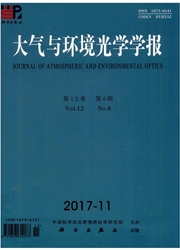

 中文摘要:
中文摘要:
利用5个航次的海上实测资料,分析了东中国海域上空气溶胶的光学性质,并利用实测资料对SeaDAS软件中的气溶胶模型在该海域的适用性进行了评估。结果表明:在该海域气溶胶大部分为弱吸收性类型(约占60%),同时也存在强散射性类型(约20%)和强吸收性类型(约20%)。气溶胶粒径体积谱主要呈双峰模式,但是在双峰之间还存在着一个不显著的次峰,因而用三个对数正态函数之和来描述气溶胶粒径体积谱要优于用两个对数正态函数之和来描述。实测资料和SeaDAS气溶胶模型的单次散射反照率的对比结果显示,在该海域具有吸收性的沙尘和烟尘气溶胶的影响不可忽略,而目前的SeaDAS气溶胶模型主要针对非吸收或弱吸收气溶胶,不能完全满足东中国海域海色遥感大气校正的需要。
 英文摘要:
英文摘要:
Based on the in situ data of five cruises, aerosol optical properties over the East China Seas are analyzed, and the SeaDAS aerosol models are also evaluated. Results show that about 60% of aerosols in these regions show weak absorption, 20% are strong scattering aerosols, and the rest 20% show strong absorption.Aerosol volume size distributions in these regions mainly have two peaks, but there is another inconspicuous peak between the coarse mode and fine mode. So it's better to describe the volume size distribution by a sum of three lognormal distributions than by two. The comparison between the in situ data and the SeaDAS aerosol models indicates that the influence of strong absorbing aerosols such as dust and soot can not be ignored. The current SeaDAS aerosol models are mainly designed for non-absorbing or weak-absorbing aerosols, and can not entirely meet the requirements of atmospheric correction of ocean color remote sensing in the East China Seas.
 同期刊论文项目
同期刊论文项目
 同项目期刊论文
同项目期刊论文
 期刊信息
期刊信息
